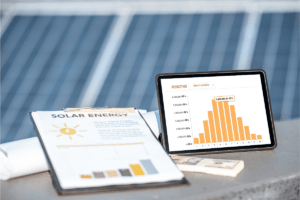Once your nonprofit has a solar system installed, what do you need to do to maintain it?
The good news is that solar is a simple and trusted technology, with no moving parts and very few components susceptible to failure (for details, see Solar Basics).
Even with such a simple technology, it’s a good idea to monitor your system — and a little basic maintenance will ensure the best performance and optimum solar production.
Do you need to do the monitoring and maintenance yourself?
If your nonprofit finances your system with a CollectiveSun Solar Loan or purchases it outright with cash, you’ll need to ensure your solar system is monitored and any required scheduled maintenance, or unscheduled repairs, are performed. That doesn’t mean you have to do it all yourself: you can hire contractors to perform the maintenance. You do need to assign someone to manage the work, and you need to account for the work in the budget for your solar project.
If your nonprofit is not well equipped to manage monitoring and maintenance, you might opt for the Easy Button “solar subscription” solution of a CollectiveSun Solar Power Agreement (SPA). This option provides benefits beyond requiring no cash upfront. We will also select a vetted installer, undertake all contract negotiations, take care of tax filings, and provide monitoring and maintenance.
Monitoring
 With a solar monitoring system, you can see how much electricity your system is producing. If something isn’t working as it should, you need to know so it can be fixed. If you notice your energy production drops significantly, it could be a sign of a malfunction, or it could indicate your panels are being obstructed by shade, debris, or dust.
With a solar monitoring system, you can see how much electricity your system is producing. If something isn’t working as it should, you need to know so it can be fixed. If you notice your energy production drops significantly, it could be a sign of a malfunction, or it could indicate your panels are being obstructed by shade, debris, or dust.
If you financed your system with a CollectiveSun Solar Power Agreement (SPA), we’ll take care of the monitoring for you. But you can still use the monitoring system to see your system’s production anytime.
A monitoring system provides you with real-time data, and you can also see historical data to track your system’s performance over time. You can access solar monitoring data on your computer or your smartphone.
Maintenance
There’s a good chance your solar panels will keep producing electricity as expected with minimal maintenance. Taking a few simple, but important, steps will ensure that your system produces as much energy as possible.
As with monitoring, if you financed your system with a CollectiveSun SPA, we’ll take care of the maintenance for you. If you financed your system another way and the maintenance is your responsibility, read on.
Cleaning your panels
In most parts of the U.S., you can expect rain to clear dust and light debris from your panels. Panels are usually installed at an angle to maximize solar generation, which helps the rain clean them. Even snow can help clean your panels; you may want to brush the snow off if the snowfall is unusually heavy, but in most cases that’s not necessary.
In most cases, rainfall is sufficient to provide appropriate cleaning. However, if your nonprofit is in an area with very low rainfall and extremely high levels of dirt or dust, it’s recommended that you clean your panels once a year. Check your monitoring system regularly; a significant drop in your system’s production could signal that the panels need cleaning.
It’s safest to hire a professional solar panel cleaning service to clean your panels. If your nonprofit prefers to handle the cleaning, follow these guidelines:
- Check your warranty. To ensure you don’t void your solar panel warranty, check it for any cleaning guidelines and be sure to follow those.
- Turn off your system. Before you start cleaning, ensure your system is off to protect yourself and the panels. Remember to turn the system back on when you’re done!
- Use a mild soap. Dish soap or a vinegar-and-water mixture are good choices.
- Use soft tools. You can use a soft brush to sweep off dirt and a soft sponge or cloth to wipe the panels down; never use rakes or hard brushes.
- Use lukewarm water. Very cold or very hot water can damage your panels.
- Rinse thoroughly. Rinse the panels when you’re done cleaning to remove any lingering soap residue, dust, or dirt.
Inspecting your system and its surroundings
From time to time, you may want to have your system inspected to identify any issues like loose connections.
Be sure to keep nearby trees and shrubs trimmed, to avoid shading as well as any debris from falling leaves.
Deterring pests
Wildlife can pose a threat to your solar panels. Birds can build nests that obstruct airflow and leave droppings on panels; rodents and raccoons can chew wires.
If wildlife is prevalent in your area, the best way to deal with these issues is to install physical barriers between the roof and the frames of the panels, sealing off the perimeter of your solar installation. These barriers may come in the form of wire mesh, perforated sheet metal, or metal spikes.
If you’re concerned about birds and rodents in your area damaging your panels, ask your solar installer if it makes sense to install pest-deterring barriers.
Keeping it simple
Remember, you’re not on your own! If your nonprofit finances your solar with a CollectiveSun SPA, we’ll handle monitoring and maintenance for you. If you pay for your solar with cash or a loan, we can help you find reputable contractors to do any needed maintenance.
CollectiveSun is here to help you before, during, and after your solar is installed. Don’t hesitate to reach out to us.
